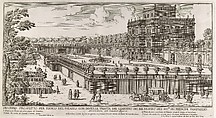View of the side facade of the Palazzo Pamphili and its garden (Secondo prospetto per fianco del palazzo con diversa veduta del giardino del Bel respiro...Pamphilio)
Simon Felice Italian
Published by Giovanni Giacomo De Rossi Italian
Not on view
With a circumference of close to six miles, the Villa Doria Pamphilj is a good example of the expansive villa garden-parks of Baroque Italy surrounded by woods and meadows of the Roman campagna. Commissioned by Pope Innocent X (Pamphilj) and built by Alessandro Algardi (1598–1654) from 1644 onward, the pleasure house in the new gardens known as the Casino had a richly sculpted facade and belvedere. As this print by Falda shows, the Casino was decorated by a set of elaborate terraces containing boxwood parterres and hundreds of orange or olive trees in pots on its surrounding balustrades. The Pamphilj family belonged to a circle of wealthy patrons, including the Borghese, Ludovisi, and Barberini, who commissioned architects (Bernini), landscape painters (Claude Lorrain), as well as botanists (Giovanni Battista Ferrari) and garden dilettantes to build and decorate their villas and gardens. The vast expanse of such a garden park with fountains and theaters made maintenance expensive and difficult. In the second half of the seventeenth century, the first signs of decay could be observed. Ironically, it was in this slightly dilapidated state, expressing the quality of picturesqueness which was so appealing to Northern Europeans, that these gardens became especially admired.
Due to rights restrictions, this image cannot be enlarged, viewed at full screen, or downloaded.


